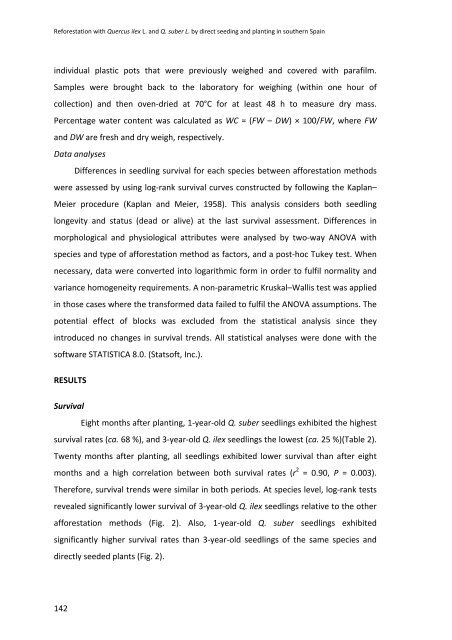Establecimiento de cuatro especies de Quercus en el sur de la ...
Establecimiento de cuatro especies de Quercus en el sur de la ...
Establecimiento de cuatro especies de Quercus en el sur de la ...
Create successful ePaper yourself
Turn your PDF publications into a flip-book with our unique Google optimized e-Paper software.
Reforestation with <strong>Quercus</strong> ilex L. and Q. suber L. by direct seeding and p<strong>la</strong>nting in southern Spain<br />
individual p<strong>la</strong>stic pots that were previously weighed and covered with parafilm.<br />
Samples were brought back to the <strong>la</strong>boratory for weighing (within one hour of<br />
collection) and th<strong>en</strong> ov<strong>en</strong>‐dried at 70°C for at least 48 h to mea<strong>sur</strong>e dry mass.<br />
Perc<strong>en</strong>tage water cont<strong>en</strong>t was calcu<strong>la</strong>ted as WC = (FW – DW) × 100/FW, where FW<br />
and DW are fresh and dry weigh, respectiv<strong>el</strong>y.<br />
Data analyses<br />
Differ<strong>en</strong>ces in seedling <strong>sur</strong>vival for each species betwe<strong>en</strong> afforestation methods<br />
were assessed by using log‐rank <strong>sur</strong>vival curves constructed by following the Kap<strong>la</strong>n–<br />
Meier procedure (Kap<strong>la</strong>n and Meier, 1958). This analysis consi<strong>de</strong>rs both seedling<br />
longevity and status (<strong>de</strong>ad or alive) at the <strong>la</strong>st <strong>sur</strong>vival assessm<strong>en</strong>t. Differ<strong>en</strong>ces in<br />
morphological and physiological attributes were analysed by two‐way ANOVA with<br />
species and type of afforestation method as factors, and a post‐hoc Tukey test. Wh<strong>en</strong><br />
necessary, data were converted into logarithmic form in or<strong>de</strong>r to fulfil normality and<br />
variance homog<strong>en</strong>eity requirem<strong>en</strong>ts. A non‐parametric Kruskal–Wallis test was applied<br />
in those cases where the transformed data failed to fulfil the ANOVA assumptions. The<br />
pot<strong>en</strong>tial effect of blocks was exclu<strong>de</strong>d from the statistical analysis since they<br />
introduced no changes in <strong>sur</strong>vival tr<strong>en</strong>ds. All statistical analyses were done with the<br />
software STATISTICA 8.0. (Statsoft, Inc.).<br />
RESULTS<br />
Survival<br />
Eight months after p<strong>la</strong>nting, 1‐year‐old Q. suber seedlings exhibited the highest<br />
<strong>sur</strong>vival rates (ca. 68 %), and 3‐year‐old Q. ilex seedlings the lowest (ca. 25 %)(Table 2).<br />
Tw<strong>en</strong>ty months after p<strong>la</strong>nting, all seedlings exhibited lower <strong>sur</strong>vival than after eight<br />
months and a high corr<strong>el</strong>ation betwe<strong>en</strong> both <strong>sur</strong>vival rates (r 2 = 0.90, P = 0.003).<br />
Therefore, <strong>sur</strong>vival tr<strong>en</strong>ds were simi<strong>la</strong>r in both periods. At species lev<strong>el</strong>, log‐rank tests<br />
revealed significantly lower <strong>sur</strong>vival of 3‐year‐old Q. ilex seedlings r<strong>el</strong>ative to the other<br />
afforestation methods (Fig. 2). Also, 1‐year‐old Q. suber seedlings exhibited<br />
significantly higher <strong>sur</strong>vival rates than 3‐year‐old seedlings of the same species and<br />
directly see<strong>de</strong>d p<strong>la</strong>nts (Fig. 2).<br />
142

















